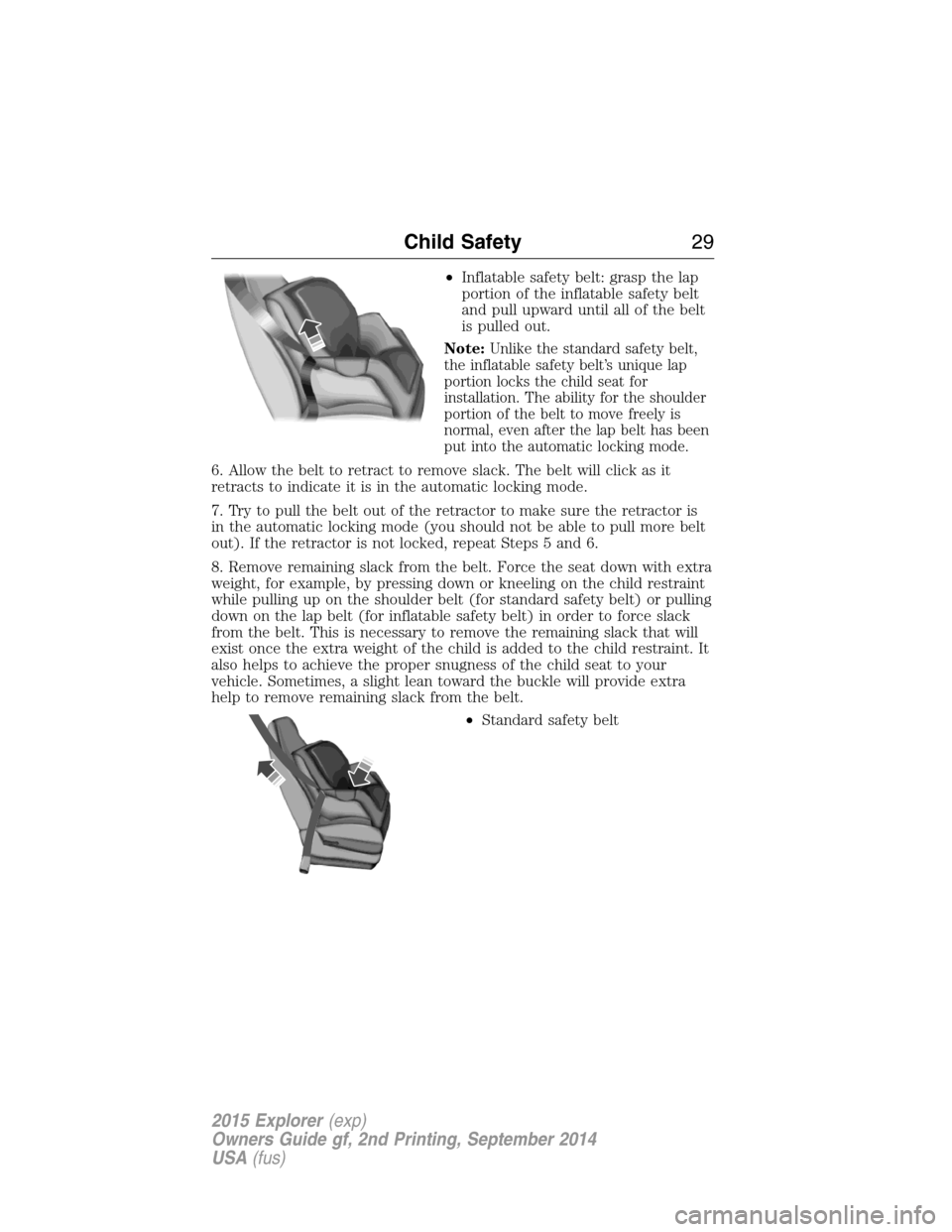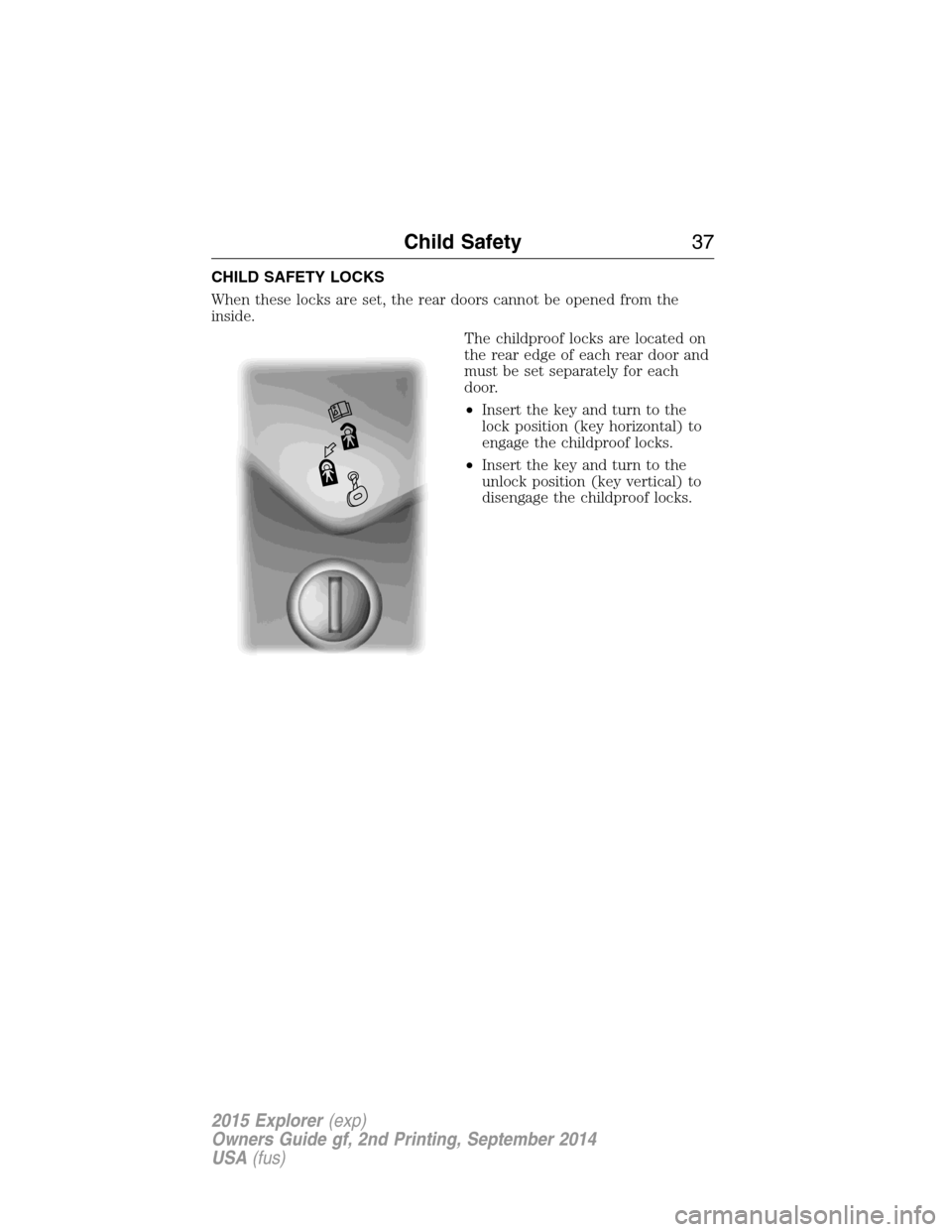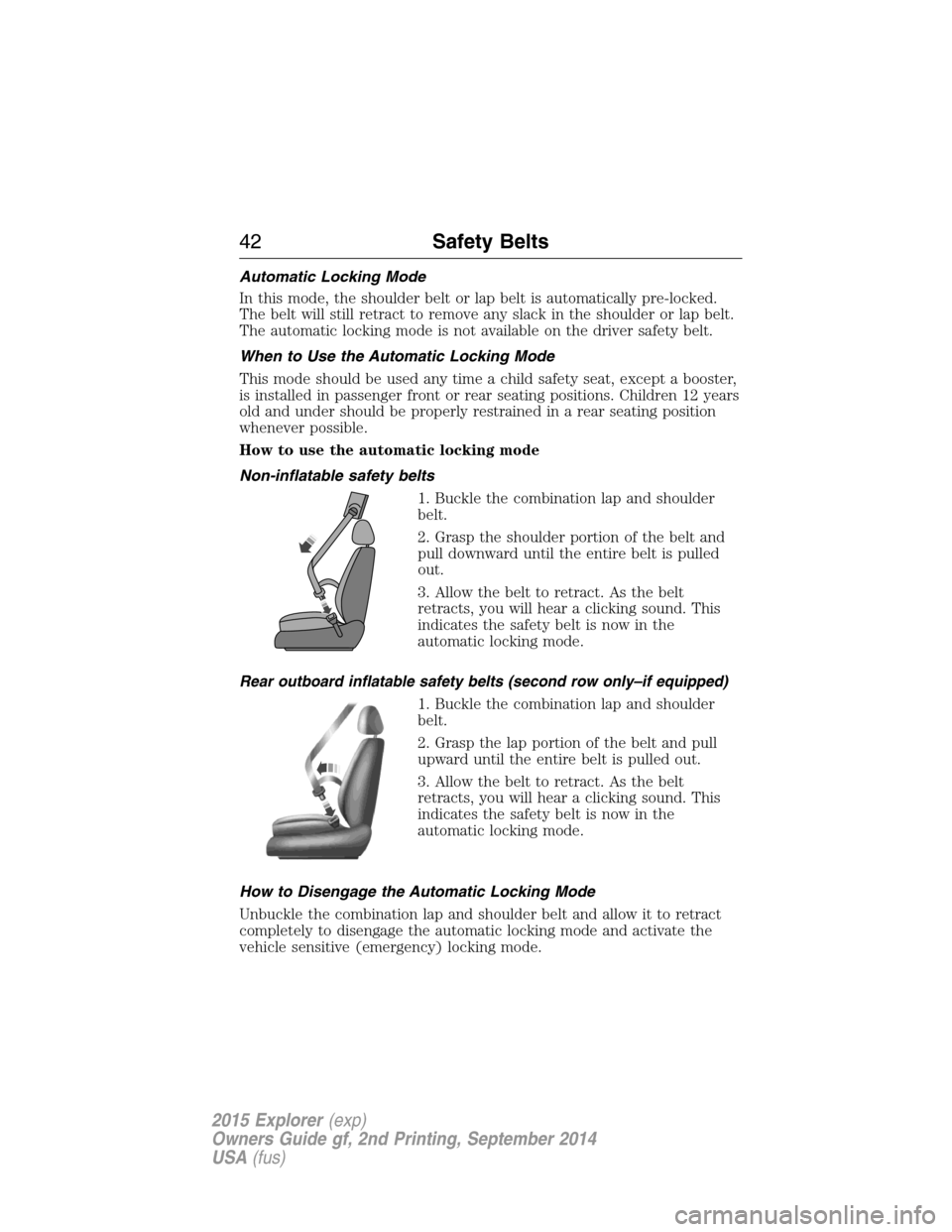2015 FORD EXPLORER lock
[x] Cancel search: lockPage 29 of 596

4. Insert the belt tongue into the proper buckle (the buckle closest to
the direction the tongue is coming from) for that seating position until
you hear a snap and feel the latch engage. Make sure the tongue is
latched securely by pulling on it.
•Standard safety belt buckle
•Inflatable safety belt buckle
5. To put the retractor in the automatic locking mode, do the following;
•Standard safety belt: grasp the
shoulder portion of the belt and
pull downward until all of the
belt is pulled out.
28Child Safety
2015 Explorer(exp)
Owners Guide gf, 2nd Printing, September 2014
USA(fus)
Page 30 of 596

•Inflatable safety belt: grasp the lap
portion of the inflatable safety belt
and pull upward until all of the belt
is pulled out.
Note:
Unlike the standard safety belt,
the inflatable safety belt’s unique lap
portion locks the child seat for
installation. The ability for the shoulder
portion of the belt to move freely is
normal, even after the lap belt has been
put into the automatic locking mode.
6. Allow the belt to retract to remove slack. The belt will click as it
retracts to indicate it is in the automatic locking mode.
7. Try to pull the belt out of the retractor to make sure the retractor is
in the automatic locking mode (you should not be able to pull more belt
out). If the retractor is not locked, repeat Steps 5 and 6.
8. Remove remaining slack from the belt. Force the seat down with extra
weight, for example, by pressing down or kneeling on the child restraint
while pulling up on the shoulder belt (for standard safety belt) or pulling
down on the lap belt (for inflatable safety belt) in order to force slack
from the belt. This is necessary to remove the remaining slack that will
exist once the extra weight of the child is added to the child restraint. It
also helps to achieve the proper snugness of the child seat to your
vehicle. Sometimes, a slight lean toward the buckle will provide extra
help to remove remaining slack from the belt.
•Standard safety belt
Child Safety29
2015 Explorer(exp)
Owners Guide gf, 2nd Printing, September 2014
USA(fus)
Page 32 of 596

Using Lower Anchors and Tethers for CHildren (LATCH)
WARNING:Never attach two child safety seats to the same
anchor. In a crash, one anchor may not be strong enough to hold
two child safety seat attachments and may break, causing serious injury
or death.
WARNING:Depending on where you secure a child restraint,
and depending on the child restraint design, you may block
access to certain safety belt buckle assemblies or LATCH lower
anchors, rendering those features potentially unusable. To avoid risk of
injury, occupants should only use seating positions where they are able
to be properly restrained.
The LATCH system is composed of three vehicle anchor points: two
lower anchors located where seat back and seat cushion meet (called the
seat bight) and one top tether anchor located behind that seating
position.
LATCH compatible child safety seats have two rigid or webbing mounted
attachments that connect to the two lower anchors at the LATCH
equipped seating positions in your vehicle. This type of attachment
method eliminates the need to use safety belts to attach the child seat,
however the safety belt can still be used to attach the child seat. For
forward-facing child seats, the top tether strap must also be attached to
the proper top tether anchor, if a top tether strap has been provided
with your child seat.
Your vehicle has LATCH lower anchors for child seat installation at the
seating positions marked with the child seat symbol.
•Second-row bucket seats and
third-row passenger side
Child Safety31
2015 Explorer(exp)
Owners Guide gf, 2nd Printing, September 2014
USA(fus)
Page 38 of 596

CHILD SAFETY LOCKS
When these locks are set, the rear doors cannot be opened from the
inside.
The childproof locks are located on
the rear edge of each rear door and
must be set separately for each
door.
•Insert the key and turn to the
lock position (key horizontal) to
engage the childproof locks.
•Insert the key and turn to the
unlock position (key vertical) to
disengage the childproof locks.
Child Safety37
2015 Explorer(exp)
Owners Guide gf, 2nd Printing, September 2014
USA(fus)
Page 40 of 596

WARNING:When possible, all children 12 years old and under
should be properly restrained in a rear seating position. Failure
to follow this could seriously increase the risk of injury or death.
WARNING:Safety belts and seats can become hot in a vehicle
that has been closed up in sunny weather; they could burn a
small child. Check seat covers and buckles before you place a child
anywhere near them.
WARNING:Front and rear seat occupants, including pregnant
women, should wear safety belts for optimum protection in an
accident.
All seating positions in this vehicle have lap and shoulder safety belts. All
occupants of the vehicle should always properly wear their safety belts,
even when an airbag supplemental restraint system is provided.
The safety belt system consists of:
•Lap and shoulder safety belts.
•Shoulder safety belt with automatic locking mode (except driver and
rear inflatable safety belt).
•Height adjuster at the front outboard seating positions.
•Safety belt pretensioner at the front outboard seating positions.
•Belt tension sensor at the front outboard passenger seating position.
•Safety belt warning light and chime. SeeSafety Belt
Warning Light and Indicator Chimelater in this chapter.
•Crash sensors and monitoring system with readiness
indicator. SeeCrash Sensors and Airbag Indicatorin the
Supplemental Restraint Systemchapter.
The safety belt pretensioners and rear inflatable safety belts are designed
to activate in frontal, near-frontal and side crashes, and in rollovers. The
safety belt pretensioners at the front seating positions are designed to
tighten the safety belts firmly against the occupant’s body when
activated. This helps increase the effectiveness of the safety belts. In
frontal crashes, the safety belt pretensioners can be activated alone or, if
the crash is of sufficient severity, together with the front airbags.
Safety Belts39
2015 Explorer(exp)
Owners Guide gf, 2nd Printing, September 2014
USA(fus)
Page 42 of 596

Pregnant women should always
wear their safety belts. The lap belt
portion of a combination lap and
shoulder belt should be positioned
low across the hips below the belly
and worn as tight as comfort will
allow. The shoulder belt should be
positioned to cross the middle of
the shoulder and the center of the
chest.
Safety Belt Locking Modes
WARNING:After any vehicle crash, the safety belt system at all
passenger seating positions must be checked by an authorized
dealer to verify that the automatic locking retractor feature for child
seats is still functioning properly. In addition, all safety belts should be
checked for proper function.
WARNING:The belt and retractor assembly must be replaced if
the safety belt assembly automatic locking retractor feature or
any other safety belt function is not operating properly when checked
by an authorized dealer. Failure to replace the belt and retractor
assembly could increase the risk of injury in crashes.
All safety restraints in the vehicle are combination lap and shoulder
belts. The driver safety belt has the first locking mode. The front
outboard passenger and rear seat safety belts have both types of locking
modes described as follows:
Vehicle Sensitive Mode
This is the normal retractor mode, which allows free shoulder or lap belt
length adjustment to your movements and locking in response to vehicle
movement. For example, if the driver brakes suddenly or turns a corner
sharply, or the vehicle receives an impact of about 5 mph (8 km/h) or
more, the combination safety belts will lock to help reduce forward
movement of the driver and passengers.
In addition, the retractor(s) is designed to lock if the webbing is pulled
out too quickly. If this occurs, let the belt retract slightly and pull
webbing out again in a slow and controlled manner.
Safety Belts41
2015 Explorer(exp)
Owners Guide gf, 2nd Printing, September 2014
USA(fus)
Page 43 of 596

Automatic Locking Mode
In this mode, the shoulder belt or lap belt is automatically pre-locked.
The belt will still retract to remove any slack in the shoulder or lap belt.
The automatic locking mode is not available on the driver safety belt.
When to Use the Automatic Locking Mode
This mode should be used any time a child safety seat, except a booster,
is installed in passenger front or rear seating positions. Children 12 years
old and under should be properly restrained in a rear seating position
whenever possible.
How to use the automatic locking mode
Non-inflatable safety belts
1. Buckle the combination lap and shoulder
belt.
2. Grasp the shoulder portion of the belt and
pull downward until the entire belt is pulled
out.
3. Allow the belt to retract. As the belt
retracts, you will hear a clicking sound. This
indicates the safety belt is now in the
automatic locking mode.
Rear outboard inflatable safety belts (second row only–if equipped)
1. Buckle the combination lap and shoulder
belt.
2. Grasp the lap portion of the belt and pull
upward until the entire belt is pulled out.
3. Allow the belt to retract. As the belt
retracts, you will hear a clicking sound. This
indicates the safety belt is now in the
automatic locking mode.
How to Disengage the Automatic Locking Mode
Unbuckle the combination lap and shoulder belt and allow it to retract
completely to disengage the automatic locking mode and activate the
vehicle sensitive (emergency) locking mode.
42Safety Belts
2015 Explorer(exp)
Owners Guide gf, 2nd Printing, September 2014
USA(fus)
Page 47 of 596

3. Wait 10 seconds after the safety belt warning light turns off.
•Step 4 must be completed within 20 seconds after the completion of
Step 3.
4. For the seating position being disabled, buckle then unbuckle the
safety belt three times at a moderate speed, ending in the unbuckled
state.
•After Step 4, the safety belt warning light will be turned on for three
seconds.
5. Within about seven seconds of the light turning off, buckle then
unbuckle the safety belt.
•This will disable the feature for that seating position if it is currently
enabled.
•This will enable the feature for that seating position if it is currently
disabled.
REAR INFLATABLE SAFETY BELT (IF EQUIPPED)
WARNING:Do not attempt to service, repair, or modify the rear
inflatable safety belt as you could be seriously injured or killed.
Note:The rear inflatable safety belts are compatible with most infant
and child safety car seats and belt positioning booster seats when
properly installed. This is because they are designed to fill with a cool
gas at a lower pressure and at a slower rate than traditional airbags.
After inflation, the shoulder portion of the safety belt remains cool to the
touch.
The rear inflatable safety belts are located in the shoulder portion of the
safety belts of the second-row outboard seating positions.
The rear inflatable safety belt consists of the following:
•An inflatable bag located in the shoulder safety belt webbing.
•Lap safety belt webbing with automatic locking mode.
•Crash sensors and monitoring system with readiness
indicator.
SeeCrash Sensors and Airbag Indicatorin theSupplemental
Restraint Systemchapter.
46Safety Belts
2015 Explorer(exp)
Owners Guide gf, 2nd Printing, September 2014
USA(fus)